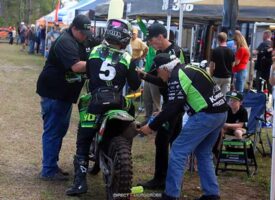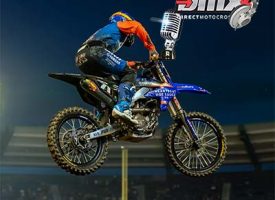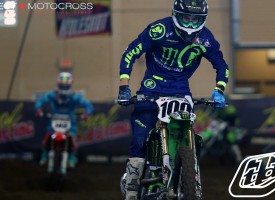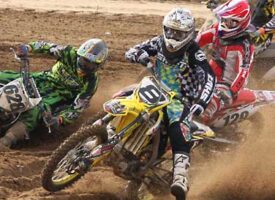Catching Up with…Sebastien Tortelli
By Billy Rainford
It’s not often we get the chance to talk to someone who has a World Championship to their credit, let alone two! When I noticed that Sebastien Tortelli was posting photos of Canadians on his ‘Champ Factory‘ Facebook page, I made an attempt to get in touch with him. And because motocrossers are the salt of the earth, he got back to me right away and said he’d be happy to do an interview with us. Cool.
He pooped into our minds a couple weeks ago when it was the 13th week for the Frid’Eh Update. He famously ran the number quite a few years ago and we wanted to get his opinion on the luck, or lack of, for the dreaded number. We talk about that too.
I tried to use the new Dragon Dictation app to type this out for me but Sebastien still has a pretty thick French accent and the program would stop every couple words making it basically useless. In the end, I was forced to type it out the old-fashioned way.
Give it a read…

Let’s find out what 2-time world champ, Sebastien Tortelli, is up to these days. – Mickael Lecuit photo
Direct Motocross: Thank you very much for taking the time to talk with us today. We got thinking about you on Week #13 a couple weeks ago. You ran it fearlessly back in the day. Could you give us a little history on your use of the dreaded number?
Sebastien Tortelli: #13 was, wow, that was when I was Factory Honda. Points-wise, I ended up with #13 and that was the year when I think they changed the system and it was supposed to be your permanent number that you could keep. The AMA was like ‘you can run it or not.’ #13 has been around me for a long time. When you go on an airplane, you’re row #13, things happen, it’s 13, and everything work well with me on #13. In France, we’re not very superstitious with 13 so it was a good number for me.
I ran it for a couple years and then when I switched to Suzuki (Roger) Decoster was the manager and said he didn’t like #13 and he had something against #13 and asked if I could change it. The first Supercross that I won at the Coliseum was with #103 which is just a zero between a number 13 so I said let’s go with #103and the AMA said it was available so I switched from 13 to 103 but it’s 13 with a zero in between.
I know you’ve talked about this stuff a million times, but would you mind backing up and telling us a little bit about yourself?
I’m from France. I was born in 1978 August in a small town of 3000 people. My parents are farmers so I grew up on the farm and started riding when I was 4 1/2 years old. My dad went to a shop and bought a motorcycle to work on the farm to be faster from one point to the other. The bike had issues and was still under warranty so I went with him to the shop a bunch of times and they had a PR, it’s like the PW, and I was always on it and asking to ride it.
One day it came for Christmas. I rode it for a couple years and then one of the neighbors came over and told my dad he should try me out at the races. He said the next weekend the races were not far from town and that we should go. We went to our first race ever and it was not a motocross race it was a ‘mud-cross’ race with mopeds. The guy told us we couldn’t race there because it was a 50 but they let me and I won the race but then they told me I couldn’t go back with them and that I’d have to go to a real motocross.
They gave me the location of the next motocross event and from there I started riding motocross almost every weekend.
You mention growing up on a farm and getting into dirt bikes that way. I think that is the traditional way it has always happened. Do you feel it’s still the same today?
The 250 2-stroke is a good way to start and it’s way cheaper than a 4-stroke. The 4-strokes take you to a higher level but when they blow up it’s way more expensive. For the younger guys, you still have 125s and 85s and 250 2-strokes which helps give you the basics. I believe 2-strokes are a good way for learning and when you’re fast on one you’re going to be fast on a 4-stroke.
4-strokes make it easy to do more difficult things and I believe more riders do bigger things than they are really capable of and as long as everything is good then there is no problem but if something happens then they don’t have the technique to correct it. That makes for more crashes and bigger injuries.
What is the amateur scene like over in Europe? Is it the same all over?
We have all the local events that are more like regions, kind of thing. When you reach 12 then you can start doing the French championships all around the country with is the size of a state for [here.] After that we have the European championship or the World championship. Basically, it’s the same as every French guy does – you do the Juniors and then you can go to the French national championships and then the European or World championship which was the process I went through.
I went through it pretty young. At the time, the French federation was doing a special selection for a youth team and they helped the youth with coaching so on your school holidays we had a couple days of coaching every school holiday and that helped a lot to progress. That helped me get to the European championships and then the World championships.
We always think everyone’s dream is to come over to the USA and race there. Is that how it was for you?
It wasn’t straight to America. During the World championships when I started having the idea to come to the US. The US was the next step. That’s the way it went for me. I won my 2 world championships and after that I moved to racing full-time in the US with Supercross and Motocross. [In France] it’s a much smaller Supercross series so I had to learn again. Motocross was pretty natural since I was doing it since I was a kid but racing Supercross was a lot tougher. I had a late learning curve.

Heading to America to race was the next logical move in Sebastien’s progression as a racer. – Champ Factory Facebook photo
How many languages do you speak?
Uh, two. (Laughs) I’m still stuck with French and English.
You’d fit in well in Canada.
I know! I’ve been to Quebec a few times. I’ve got some friends up there at KTM. I met Jean Sebastien Roy when he was doing the championships here and Florian (Bourget) from KTM is a good friend of mine. Canada feels like home.
As an amateur you never came over to any of the big amateur championships races then?
Nope. I never came over for those. I came to the states in January so I went to some of the local events which were pretty big at the time and that helped a lot at the start.
Who were your biggest rivals when you competed in the GPs?
The biggest one was Stephan Everts. He’s the one I battled to get the championship and it came down to the wire – last moto, last round. Whoever won the last moto of the season was the champion. That was a great battle for 15 rounds. That would have been 1998.
Are you and Stephan buddies?
Ya, we’re good friends. He’s not my best friend but he’s a good friend.
When you first came to the US, did you notice a difference in the overall moto scene or is it the same everywhere?
No, the sport is way bigger in the US than in Europe. There are a lot more riders so so it was a lot different, that’s for sure. It makes a big difference when you have way more riders on the gate, and more riders at the practice tracks. The tracks are well-maintained here. And you can always ride. That’s something that I was not used to. When I was riding in Europe, you have the tracks open on the weekend and they are only rebuild once a year so it’s pretty rough.
Coming here, everything is geared towards motocross. For racing it’s perfect.
I’m older than you are and ‘back in the day’ Europeans were know for having a different tiding style than the looser Americans. Is that still the case, would you say?
The way the bikes are set up is a little bit different. The suspension is a little bit different – they ride the back end a little bit higher than over here. Because the conditions and the way the tracks are, they ride with the back end a little bit lower beause it’s a little bit more rough and there are more jumps so the riding style is a little bit different.
Europeans used to stand up a lot through the motos where in the US you sit down a little bit more.
Who would you say is the best rider you’ve ever seen?
I’ve never thought about that. Good question. The best rider that I’ve ever seen in the sand is Stephan Everts. For me, he was very impressive , very smooth and he was able to master the sand like he was just flying.
As far as dirt, RC (Ricky Carmichael) was good where nothing would make him back down. That was his strong point. He would never give up and he was strong all the way through. That was part of what makes him who he is. No matter what the conditions, he was the one who could step it up.
These days, I like the style of (Ryan) Villopoto. I like the way he rides and the way he attacks the track. He’s someone I like to see ride a lot.
Speaking of him. Is he going to win the MXGP World Championship?
It’s looking pretty rough right now. I was definitely expecting a little bit better from him. I knew the first 5 would be tough rounds for him but he’s right there. He just has to learn. The tracks are a little bit different than what he’s used to. The championship is still on and now he has a DNF in one moto [This interview was done before Valkenswaard] and that’s going to make it a little bit tougher. Speed-wise, he doesn’t need to panic. I think he needs to get a little more comfortable. The championship might be tough but I still want to know if he can get it.

You’ll find Sebastien in Temecula, California, training riders at his Champ Factory. Oh, and watch for him at Loretta Lynn’s this summer too!
Have you been following our national series at all over the years?
A little bit. Ya, I know you had (Brett) Metcalfe who cameand some of the US guys who came like (Austin) Politelli and more guys so I’ve been looking at it. We have quite a few Canadians who come here to train so for sure I’ve been looking t it a little bit more.
Why did you quit racing and what did you do right after?
I quit racing for a couple reasons. First is that I have two kids and that makes you a little bit wiser, I guess. The second is a good friend of mine, Ernesto Fonseca, got paralyzed at around the same time and I said that if I got a big injury that it was my last one, no matter what it was. Racing is awesome. We know the risks and, as a racer, it’s possible that you could get paralyzed or more. For me, you know it but you take it into consideration but it’s not right there on your mind and when it comes into the back of your mind and you’re thinking about it that, for me, was the time to stop.
When you start thinking bout something like that it’s the time when it happens. When that idea was right there and I was thinking in the back of my head…I was under contract with KTM for two more years and I dislocated my hip and blew my ACL at the same time and I was like, “I’m done.”
They said that I was still under contract but I didn’t want to go out and collect a paycheck just because we have a contract and just ride half way to get paid. If I’m on the track, I’m the type of guy who wants to be racing 100% so I told them I’m done. They don’t get what they need and I don’t get what I want. So it was time to retire. Pit Birer was very good about it and that was it. They told me that if I changed my mind and wanted to start racing again they would honour the contract I had and finish it with them.
I just enjoyed my kids for a year and stopped training and riding for a year. I didn’t touch a bike for a year. After that, I needed to ride. It’s in my blood. I couldn’t stop. I started managing Perris Raceway with Ricky Johnson as a partner. I did that for a couple years and it wasn’t what I liked. I was at the race track but I wasn’t doing what I liked so that’s when I switched to Champ Factory in Temecula, California.
I started it in 2007 where I could teach younger riders t help them learn what they could improve and use my experience as a racer and become a coach. That’s what I’ve been doing because that’s what I like. I like when I’m on the track and I like my guys and I like when I can see what’s wrong and change it and make it better and help them not make the mistakes that I did. That’s what is good for me. That’s what I like. When it happens, that’s when I feel good.
We go to all the tracks and some open land in the hills when it rains…all that stuff. My guys come stay with me and train for a month or 6 months. We have a house and everything set up for it. They come and train for a few months and then go back home and race. I plan their schedule as far as riding, racing, physical training, so it’s balanced.
I saw on your Facebook page that you were training some Canadians. Do you get a lot of people from up here?
Ya, I’ve got a few Canadians who come every winter and this year I got a few more. It’s been nice getting them ready and seeing where they’re lacking in speed or how it is possible to make them better with them working on their technique. I believe that it’s not doing only motos to make you go faster, it’s knowing naturally how to react and how to position yourself at the right time at the right place to go faster.
Canadians are always welcome.
I also saw that you are planning to race Loretta Lynn’s this year. What’s that all about?
Ya, I’m planning on it. I raced the California Classic in the +30 for my first time back just for the fun of it. I’ve been to Loretta’s the last few years and I’ve seen the track and I thought I should go there and start racing it. I’m going to the qualifiers and I’m planning on doing it and my guys are going to be there so it will be easy for me to get there and I’ll go for the +25 and +35 I guess.
Do you think you’ll have the same pre-race nerves as you did when you were racing full-time?
No, it’s not the same. My period is over. Now I’m just doing it for the fun of it so my focus is more on my guys. I’m going there because I like to ride and I like to ride the track. I’ve never raced it before so it’s one of the races I need to do before I really get too old.
I don’t think they get too many 2-time world champions there!
2-time world champions maybe not but they get multi-time US champions but not 2 world championships.
Is Carmichael going to show up again?
I don’t know! I heard that Tim Ferry will be there. It’s really cool.
One last question. Who was the toughest guy to race against in the United States?
RC. I would have a US championship if he wasn’t there. He was a tough guy to beat. I beat him straight-up but over a championship he got the best of me. The first year I was here I could have had the championship but I collided with Doug Henry when I was leading the championship by like 30 points and I wasn’t able to finish the season so that’s unfortunate. But that’s the way life is. Maybe that was for a better future.
Thanks again for talking with us today. Is there a list of people you’d like to thank?
Sure. I want to thank Renthal, Yamaha, 100%, and all the guys who support the school. They’ve been with us for years and I’m happy to have such strong partners.




